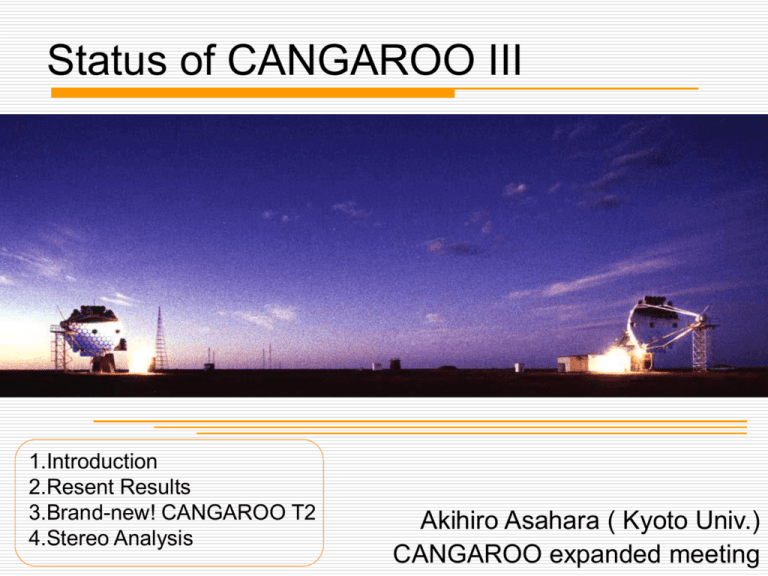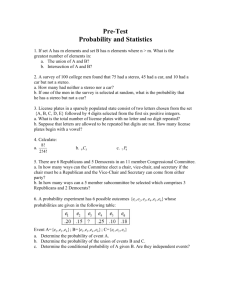Status_of_CANGAROOIII
advertisement

Status of CANGAROO III 1.Introduction 2.Resent Results 3.Brand-new! CANGAROO T2 4.Stereo Analysis Akihiro Asahara ( Kyoto Univ.) CANGAROO expanded meeting Collaboration of Australia and Nippon for a GAmma Ray Observatory in the Outback An array of imaging atmospheric Cherenkov telescopes to detect highenergy gamma-rays from celestial objects in Woomera, Australia CANGAROO team University of Adelaide Australian National University Ibaraki University Ibaraki Prefectural University Kanagawa University Konan University Kyoto University Nagoya University National Astronomical Observatory of Japan Osaka city University The University of Tokyo (ICRR) Shinshu University Institute for Space and Aeronautical Science Tokai University Tokyo Institute of Technology Yamagata University Yamanashi Gakuin University 17 institutes join this project. Observation Method Gamma-ray simulation Camera image Proton simulation Alpha plot Observation Data (Crab Nebula) α distribution (simulation) ON run OFF run Residual Gamma Proton CANGAROO 10m telescope Upgraded to 10m in 2000 114 x 80cm CFRP mirror segments (first plastic-base mirror in the world!) Focal length 8m Alt-azimuth mount 552ch imaging camera Charge and timing electronics (March 2000) 552ch PMTs TeV gamma-ray sky ~ 2002 Grade A Grade B Grade C CANGAROO FOV (El > 40 degree) Red: Grade A TeV sources Blue: Grade B Black: Grade C 3 Pulsar nebulae Crab Vela PSR 1706-44 8 Blazars Mrk 421 Mrk501 1ES2344+514 PKS2155-304 3C66A BL Lac 1H1426+428 1ES1959+65 3 Supernova remnants SN1006 Cas A RX J1713.7-3946 1 X-ray Binary Cen X-3 1 Starburst galaxy NGC253 SNR RX J1713.7-3946: emission from protons? Hard to explain by emission from electrons (Brems, IC) Emission from protons(0)? Cosmic ray origin? Enomoto et al. Nature 2002 Starburst galaxy NGC 253 Multi-wave-length spectrum of Galactic Halo Itoh et al. A&AL 2002 Itoh et al. ApJL 2003 Non-thermal radiation from Galactic Halo Radio Optical New kind of TeV source Similar in size to our own galaxy Nearby spiral galaxy (2.4Mpc) Broad emission region. CANGAROO Mrk 421: hint for cosmology? 5TeV Okumura et al. ApJL 2002 Emission above 20 TeV Fewer IR backgroun photons? Cosmology: galaxy formation PSR 1706-44 Peak intensity of detected TeV gamma-ray flux becomes ten times stronger than that of X-ray flux from the nebula. TeV gamma-ray flux is difficult to explain by Sync-IC The magnetic field is too week. (2.7k CMB) model in the nebula. Nebula ~10arcsec Chandra ACIS Image (0.7-9 keV) Kushida, 2003, Ph. D thesis, Tokyo Inst. of Tech. Detected Positive Upper limit Other Targets Signal SNR/Pulsar Crab SNR SN 1006 SNR RCW 86 SNR RX J0852-4622 SN 1987A PSR 1259-63/SS2833 PSR 1509-58 PSR 1420-6048 Vela pulsar AGN PKS 2155-304, PKS 2005-489 AGN PKS 0548-322 EXO 055625-3838.6 Galactic Center/Sgr A* Galactic jet object SS433 Galaxy The Small Magellanic Cloud EGRET un-ID 3EG J1234-1318 Status Finished On analysis On analysis On analysis Finished; In prep. Finished; In prep. On analysis On analysis On analysis Finished; In prep. On analysis On analysis On analysis On analysis On analysis On analysis CANGAROO-III project Caution! This is prospective image. Time schedule 10m X 2 10m X 3 10m X 4 Observation Sep 2003 EXO 0556 RX J0852 RCW86 Stereo Targets SN1006 ’03 PSR 1706, RXJ 1713 ’04 Stereo observation Better angular resolution =0.25(One month observation) 0.15(event by event) Better energy resolution E/E=30%15% And improvement of S/N ratio. Merit of Stereo (1) Angular resolution 0.05 deg (Stereo) Single Telescope ~0.25deg (one month observation) 10m X 2 Stereo Telescope ~0.15deg (event by event) ~0.05deg, or better than that!! (one month observation) TeV g-rays from shell-type SNRs 0.25 deg (Single) Detailed mapping Of the emission region SN1006 significance map (CANGAROO 10m single) Merit of Stereo (2) Alpha <15゜ 952±137events(6.9σ) 750±60 (12σ) 0.45<E(TeV)<6.25 Stereo observation Effective area → ×0.8 S/N → ×6 ~7 (Enomoto et al. 2002) Present status: Three 10m telescopes in Woomera Started operation in Dec. 2002 T2 Assembled in Dec. 2002 T3 In operation since 2000 T1 10m telescope No.2 Completed in 2002 Focal length 8m Improved FRP mirror segments 427ch imaging camera Placed Hex; FOV 4.0 HV imposed on each PMTs 4.0° (CANGAROO T2) T2 event samples TDC PMT hit Scaler ADC Star Info. Stereo Analysis DAQ phase I (current): Both telescopes are operated Independently. Attached information on T2 data: •Trigger delay time (1nsec resolution). •Current event number of T1. Stereo analysis is conducted on off-line. Stereo Trigger rate T1 rate after cut ~2Hz T1: trigger rate ~ 40Hz T2: trigger rate ~ 30Hz Coincidence ~ 2Hz The Stereo trigger rate is limited by T1. Trigger delay time -1.0515 0.02 ns/min Measured by TDC -1.105 ns/min Calculated from Telescope movement OFF-line stereo analysis is working well. ADC spectrum of T2 Red: Blue: Pink: ADC spectrum of T2 ADC spectrum of T2 made from the data triggered by T1 Power law function (index -2.7) Eth(blue) / Eth(red) ~ 4 T2 Energy threshold ~ 200GeV Stereo Events TDC (hit timing) T1 Distribution of Arrival directions (not ready) T2 ADC (light intensity) Sensitivity of CANGAROO III 0.01Crab (@200GeV) Typical Observation time (ON-OFF total): 80h/month Summary Stereo Observation Started in Dec 2002!! Telescope 2 is in expected performance. Energy threshold ~ 200GeV •Telescope 3 will be started in Aug 2003. •Telescope 4 will be started in Dec 2003. Sensitivity will become ~ 0.01Crab (@200GeV, 20 hour). CANGAROO team published 3 papers in 2002. •RXJ1713 (Enomoto et al. , Nature) •NGC253 (Itoh et al. , A&A) •Mrk 421 (Okumura et al. , ApJ) And we have several papers in prep.


